Swallow's Nest Organ

A swallow's nest organ is an organ that is not built on a horizontal floor, but is usually mounted at a great height on or in front of an inner wall. Older swallow's nest organs rest on console constructions , which are often designed as small basket-shaped galleries . Modern organs are also hung on steel cables.
history

The name swallow's nest organ goes back to Michael Praetorius , who in his Syntagma musicum (vol. 2, 1619) said about the construction of the “very first organ works” that they were “set up high by the choir as swallow nests”. With the advent of the Gothic , the organ found its way into many churches. The oldest church organs were often Swallow organs what they owed practical reasons: In the Christian liturgy the organ filled henceforth an important function and was therefore in the nave in chorus nearby places. From the 15th century, larger swallow's nest organs already had a Rückpositiv and a free-standing pedal next to the main work . Often the instruments of the Gothic and Renaissance were provided with richly painted double doors, as can be seen from contemporary images. These folding doors were installed for artistic and aural reasons, but also for practical reasons, in order to protect the organ from bird droppings and other soiling. In the Advent and Passion times, the double doors could be closed, according to the practice of closing the double doors of an altarpiece . The backs of the doors were also painted. At the bottom, the swallow's nest organ is usually closed with a carved substructure that ends in a point. In addition, the shape of the swallow's nest organ is not very uniform.
Up to the 17th century the organ mainly fulfilled a liturgical function alternating with choir, congregation and individual singers (" alternatimpraxis ") and took over individual parts of the mass and the church times in the form of organ verses . The medieval swallow's nest organs were therefore often placed near the altar. The organ was only used from the first half of the 17th century to accompany the church song , in particular to support the singing that had fallen into disrepair during the Thirty Years' War . In France and Northern Europe, the larger instruments required were preferably installed on the west gallery, while the swallow's nest organs became less important. The larger galleries also made it possible to make music together with the choir and instruments, which was particularly common in Central Germany. Swallow's nest organs were not built again until the 20th century, either as a large organ or as a stylistic addition to the main organ. The decisive factor for the construction of a swallow's nest organ on the long sides of the main nave is usually the acoustically favorable location for accompanying the parish singing. In recent times, aspects of monument preservation also play a role.
Gaming table
In the case of a mechanical game mechanism , the game table can be attached to the front, back or side. With modern swallow's nest organs, it is often far away from the organ, so that the organ can be played electrically from there or from the main organ. The double organ in Bedheim is unique . Here the swallow's nest organ is played by the second manual of the main organ, whereby a mechanism by means of wooden strips (so-called abstracts ) bridges a distance of 20 m above the organ floor. The console can also be on the organ case; the organist then gets there via hidden stairs and entrances, recently also (as in Regensburg Cathedral ) by an elevator, which can also be hidden from the view of the worshipers.
Organs (selection)
The following sortable list is a selection and focuses on swallow's nest organs in Germany.
In the sixth column, the Roman number denotes the number of manuals , a capital P denotes an independent pedal, a small p denotes a pedal that is only attached, and the Arabic number in the penultimate column denotes the number of sounding registers .
| place | church | image | Organ builder | year | Manuals | register | Remarks |
|---|---|---|---|---|---|---|---|
| Bamberg | Bamberg Cathedral |
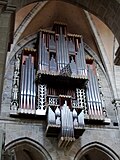
|
Rieger Orgelbau , Orgelbau Goll | 1974 | IV / P | 77 | With Spanish trumpets |
| Bedheim | St. Kilian |

|
Nicolaus Seeber | 1721 | I. | 7th | A mechanical construction of 20 m long wooden abstracts is connected to the main organ and can be played from the lower manual |
| Berlin | St. Hedwig's Cathedral |

|
Johannes Klais | 1975-1977 | III / P | 67 | |
| Bremen | Bremen Cathedral |

|
Van Vulpen Brothers | 1965-1966 | III / P | 36 | So-called. "Bach organ" |
| Brussels | Cathedral of St. Michael and St. Gudula |

|
Gerhard Grenzing | 2004 | IV / P | 63 | |
| Chartres | Chartres Cathedral |

|
Danion-Gonzalez | 1971 | IV / P | 67 | |
| Coimbra | Mosteiro de Santa Clara |
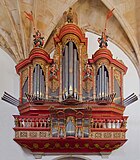
|
Manoel Benito Gomez de Herrera | 1719-1724 | II / P | Restored to its original condition in 2004–2008 | |
| Dortmund | Marienkirche |

|
Gustav Steinmann | 1967 | III / P | 34 | In the neo-baroque style ; lateral |
| Frankfurt am Main | Old Nikolaikirche |

|
Gebr. Oberlinger | 1992 | II / P | 23 | Mechanical game and stop action; Organ case with very shallow depth |
| Frankfurt am Main | Imperial Cathedral of St. Bartholomew |

|
Johannes Klais | 1994 | II / P | 28 | Can also be played electrically from the main organ |
| Freiburg in Breisgau | Freiburg Minster |
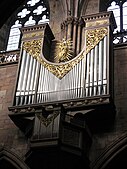
|
Marcussen & Søn | 1965 | II / P | 21st | Can also be played electrically from the main organ |
| Gelnhausen | Marienkirche |

|
Ratzmann , Schmidt | 1879/1966 | III / P | 38 | Ratzmann case preserved, organ work by B. Schmidt rebuilt in 1966, with console moved from the original case in a balcony-like manner. |
| Gonnesweiler | Holy Spirit |

|
Christian Gerhardt | 1960 | II / P | 13 | Instrument divided into two parts; The main work and 2 of the 3 pedal registers form the swallow's nest; the rest is on the gallery |
| Groningen | The aa-kerk |
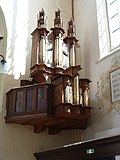
|
Hermann Raphael Rodensteen | around 1550/1635 | II / P | Only case preserved → Organs of Der Aa-kerk (Groningen) | |
| Herford | Herford Cathedral |
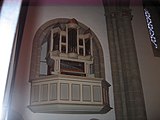
|
Paul Ott | 1953 | II / P | 21st | Behind the historical prospectus of an organ by Johann Andreas Zuberbier (1756), which was originally built for Friedewald (I / p / 9) |
| Bad Hersfeld | City Church |
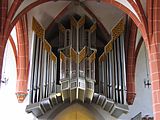
|
Bruno Döring | 1974 | III / P | 57 | With Echowerk without its own manual |
| Hildesheim | Hildesheim Cathedral | Seifert | 2014 | IV / P | 77 | ||
| innsbruck | Court Church |

|
Jörg Ebert | 1561 | II / p | 15th | Almost completely preserved → Organ of the Innsbruck Court Church |
| Cologne | Cologne cathedral |
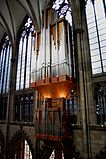
|
Johannes Klais | 1998 | IV / P | 53 | Can also be played electrically from the main organ; does not hang on the wall, but with 4 steel cables on the iron roof structure of Cologne Cathedral |
| Lemgo | St. Mary |
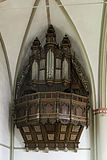
|
Gebr. Slegel , Fritz Scherer , Rowan West | 1587, 1612-1613, 2009-2010 | III / P | 27 | Slegel Housing; some remains from Scherer received; Reconstruction by West (II / P / 20) → Organ from St. Marien (Lemgo) |
| Mülheim - Saarn | Monastery church |

|
Friedrich Fleiter | 1991 | III / P | 25th | With coupling manual; Hauptwerk and pedal can also be played electrically from the gallery organ |
| Nuremberg | St. Lorenz |
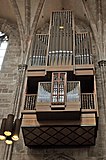
|
Johannes Klais | 2005 | III / P | 32 | |
| regensburg | Minorite Church (Historical Museum) |

|
Bernhardt Edskes | 1988-1989 | II / P | 11 | Reconstruction of the swallow's nest organ (15th / 16th century) based on a layout by Caspar Sturm (1583) |
| regensburg | Regensburg Cathedral |

|
Rieger organ building | 2009 | IV / P | 80 | Largest swallow's nest organ in the world |
| Salzburg | Salzburg Cathedral |

|
Johann Pirchner | 1991 | each II / P | 14 each | Two crossing organs |
| Strasbourg | Strasbourg Cathedral |

|
Johann Andreas Silbermann , Edmond Alexandre Roethinger , Alfred Kern & fils | 1491, 1981 | III / P | 47 | Brochure by Friedrich Krebs (1491), pendent of the organ brochure from 1385 |
| trier | Trier Cathedral |

|
Johannes Klais | 1974 | IV / P | 67 | 1996 Klais choir organ also built as a swallow's nest organ (II / P / 25) |
| Ulm | Ulm Minster |

|
Rieger organ building | 1960 | II / P | 20th | With the Alphorn register |
| Worms | Worms Cathedral |

|
Johannes Klais | 1985 | III / P | 34 |
literature
- Friedrich Jakob u. a .: The Valeria organ . vdf-Hochschulverlag, Zurich 1991, ISBN 3-7281-1666-1 ( limited preview in Google book search).
- Philipp CA Klais: About hanging and floating. Selected swallow nest solutions from the Klais workshop . In: Roland Behrens, Christoph Grohmann (eds.): Dulce melos Organorum, Festschrift Alfred Reichling for his 70th birthday . Society of Organ Friends, Mettlach 2005, p. 319-336 .
- Michael Praetorius : Syntagma musicum. Volume II. De Organographia . Bärenreiter, Kassel [et al.] 1985, ISBN 3-7618-0183-1 (facsimile by Wolfenbüttel 1619).
- Maarten Albert Vente : The Brabant Organ. On the history of organ art in Belgium and Holland in the Gothic and Renaissance ages . HJ Paris, Amsterdam 1963.
Web links
Individual evidence
- ^ Praetorius: Syntagma musicum , p. 94.
- ^ Muri monastery church : probably 12th century (as of December 1, 2009).
- ^ Vente: Brabanter Organ , p. 12.
- ↑ Jakob: Valeria organ , pp. 127–141.
- ↑ See the examples in Jakob: Valeria-Orgel , pp. 143–162.
- ↑ Hans Klotz: About the organ art of the Gothic, Renaissance and Baroque. Music, disposition, mixtures, lengths, registration, use of the pianos . 3. Edition. Bärenreiter, Kassel 1986, ISBN 3-7618-0775-9 , p. 27 .
- ↑ Hans Martin Balz : Divine Music. Organs in Germany . Konrad Theiss, Stuttgart 2008, ISBN 3-8062-2062-X , p. 14 (230th publication of the Society of Organ Friends).
- ↑ The Organs of Bedheimer Kilian Church , accessed on May 1, 2016
